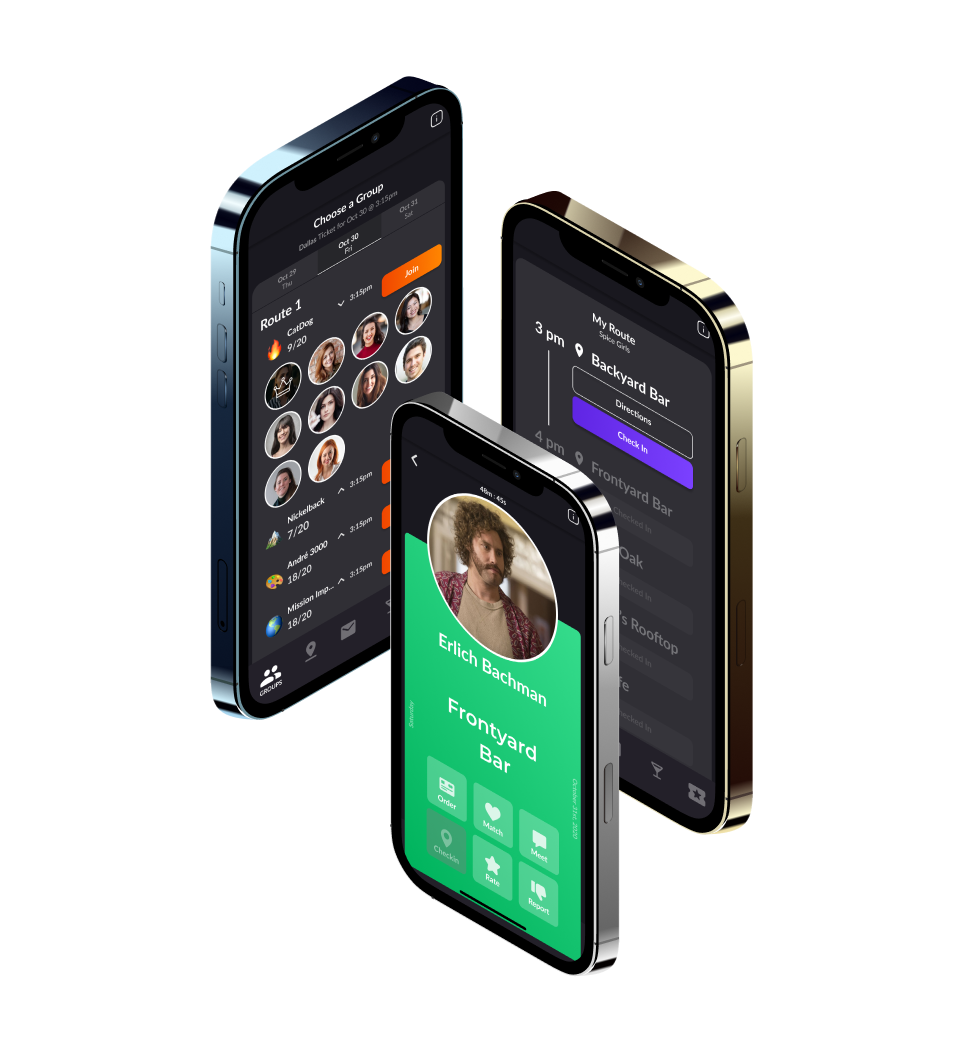
Blockparty Group
April - December 2020
Team: 8 person startup
Technical product manager developing an app to reduce the risk of COVID for bar patrons.
Summary
As of writing this, the United States has reported 23 million coronavirus cases and over 385,000 people have died. Regardless, Americans continue to go out to bars during the COVID-19 global pandemic. While it’s impossible to eliminate the risk of coronavirus in bars, my team worked to reduce the risk of super-spreader events as much as possible using a routing algorithm to direct foot traffic.
While I had no intention of going to bars, I approached this as an opportunity to add a layer of risk-mitigation to an inherently risky activity.
The Problem
As restaurants and bars began to open back up in July and August, it became apparent that people would go out no matter the risk. Blockparty Group, an event marketing company that ran bar crawls prior to COVID-19, then began to ask how could people go to events, have a great time, and minimize their risk without even realizing it?
When I joined the team my job was to solve the following problem:
How can we simultaneously help struggling bars and restaurants while minimizing the risk of coronavirus for people who want to go out?
Ideation
Who is looking to go out to bars during a pandemic in the first place? Our typical user is broadly:
- 21-30 years old
- Heavy social media user
- Lives in a young neighborhood in a medium-sized city
- Not concerned about coronavirus
In addition to appealing to our typical user, our solution needed to fit a few additional parameters:
- Absolutely MUST help venues follow local COVID guidelines
- Add value to all partnered venues via guaranteed guests
- Reduce risk without attendees perceiving a sacrifice in experience quality
Taking Blockparty’s brand identity and value proposition into account, we began to discuss routing algorithms – a way to programmatically route attendees between different bars. This way we could make sure attendees visit each partnered venue while preventing any one venue from exceeding its maximum capacity.
This sounds good on paper, but in practice no bar is safe from COVID. Bars are crowded, closed spaces where people take off their masks to drink and certainly break the 6-foot minimum social distance.
Unfortunately, there was nothing that we could do to address that problem.
By assuming that we could not address this factor, our priority became reducing the risk of one infected person creating a super-spreader event.
The Solution
A super-spreader event (like this) occurs when just one person is able to come into contact with many other attendees. In a traditional bar or bar-crawl experience, there’s a chance that one infected person may come into contact with every other attendee.

In the event that people will be mingling in enclosed spaces like bars, our best option is to limit the amount of other unique guests that any one person can come into contact with.
In order to accomplish this, I developed a routing algorithm based on batching. Users join groups and each group has a unique route. This allows us to not only control the number of people in each group and ensure bars don’t overshoot their maximum capacity, but it also ensures that groups cannot mingle.

This routing system provides some risk-mitigation for guests, helps bars get business, and fits well with the existing Blockparty model.
Our CEO and I worked together to create the product design using Figma.

These are the screens to join a group, see a route, and show your ticket.
Development
Our dev team (just me and one other full stack developer) made it a reality using React-Native, TypeScript, GraphQL, and PostgreSQL.
The mobile app with a routing system and backend API were not our only technical challenges. Users needed a way to sign up for an event and become users on the app.
In the past, Blockparty attendees bought tickets via Eventbrite and showed them at the door. Now, attendees would need to buy tickets, seamlessly login on the app, and show their virtual-ticket at the venue.
Ticket purchases must then be quickly created in our database and tied to a user so that they can go straight from buying a ticket to using the app.
Initially, we set up a simple Zapier connection between our purchase form and our database. Once a user purchased a ticket, their information would be posted accordingly.
Unfortunately, Zapier has a polling interval of several minutes if you're not paying a huge amount monthly. Our support line began filling up with users upset that the app didn’t recognize them immediately.
To make matters more complicated, data from previous Blockparty events indicated that we would receive a large influx of concurrent ticket purchases close to the event date. We needed to make sure that ticket purchases were posted and that Zapier didn’t break as multiple requests came in at the same time.
To solve this, we created a custom solution using AWS. Our team worked with Blockparty advisors to architect a system using AWS Simple Queue Service and Lambda functions to solve our problem and speed up what was formerly a minutes-long process to on average 5 seconds.

I developed our webhook and lambda functions, connected it to our purchase form, and we immediately stopped receiving any complaints about our sign up not working.
Reflection
Our app debuted Halloweekend 2020. 3,100 users in 12 cities across 3 days used our app during their night out.
This project was the first time that I led development of a product with such a large initial release. Beta testing is one thing, but public release to thousands of users is another entirely.
While leading development, I learned the hard way that thorough planning makes all the difference when it comes to development time but planning for flexibility is just as important when working on a fast-paced team.
Drafting our development sprints and prioritizing feature requests taught me how to properly schedule tasks, but I’m still understanding how to strike the balance between a guaranteed and aggressive timeline.
Handling less-than-cheery customer support tickets has made me even more polite to customer service representatives. Seriously, responding to complaints during the event was tough and I have nothing but respect for support representatives. It’s a challenging and vital job.
I was also able to hone my full stack technical skills while working at Blockparty and even learned how to properly build products for scale.
Overall, this was an incredible chance to get hands-on experience solving a problem and rapidly deploying a solution. I’m looking forward to using the lessons I learned at Blockparty to become a better product manager, engineer, and leader in the future.